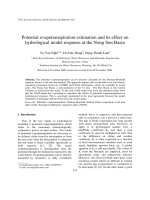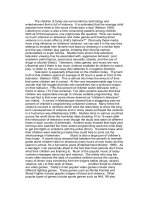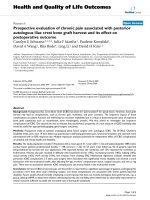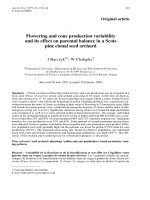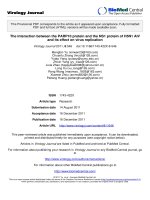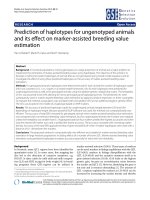Self medication practice among health care professionals and its effect on patients or clients at tikur anbessa specialized hospital, addis ababa, ethiopia
Bạn đang xem bản rút gọn của tài liệu. Xem và tải ngay bản đầy đủ của tài liệu tại đây (458.68 KB, 83 trang )
Self-medication practice among health care professionals and its effect among patients/
clients......
Self-Medication Practice among Health Care Professionals and Its Effect on
Patients or Clients at Tikur Anbessa Specialized Hospital, Addis Ababa, Ethiopia
Addis Ababa University
College of Social Science
School of Social Work
By: Tigist Belete (BSc)
Advisor: Zena Berhanu (PhD)
A Thesis Submitted to School of Social Work, Addis Ababa University Presented
in Partial Fulfillment of the Requirements for the Degree of Master of Art (Social
Work)
July, 2017
Addis Ababa, Ethiopia
1
Self-medication practice among health care professionals and its effect among patients/
clients......
Self-Medication Practice among Health Care Professionals and Its Effect
on Patients or Clients at Tikur Anbessa Specialized Hospital
Tigist Belete Hailemichale
A Thesis Submitted to School of Social Work, Addis Ababa University
Presented in Partial Fulfillment of the Requirements for the Degree of
Master of Art (Social Work)
Addis Ababa University
Addis Ababa, Ethiopia
July, 2017
2
Self-medication practice among health care professionals and its effect among patients/
clients......
Addis Ababa University
School of Graduate Studies
This is to certify that the thesis prepared by Tigist Belete Hailemichale, entitled Self-Medication
Practice among Health Care Professionals and Its Effect on patients or clients at Tikur Anbessa
Specialized Hospital and submitted in partial fulfillment of the requirements for the Degree of
Master of Arts (Social Work) complied with the regulation of the University and meets the
accepted standards with respect to originality and quality.
APPROVED BY THE EXAMINING BOARD
Internal Examiner--------------------------- Signature ----------------------- Date ----------------------
External Examiner-------------------------- Signature------------------------ Date-------------------------
Advisor ------------------------------------- Signature ------------------------- Date-------------------------
3
Self-medication practice among health care professionals and its effect among patients/
clients......
Declaration
I declare that Self-Medication Practice among Health Care Professionals and Its Effect on
Patients or Clients at Tikur Anbessa Specialized Hospital is my own work and that all the
sources that I have used have been indicated and acknowledged by means of reference and that
the work has not been submitted before at any other institutions.
Tigist Belete Hailemichale
Signature: ___________________________
Date: _______________________________
Place: Addis Ababa University, Ethiopia
4
Self-medication practice among health care professionals and its effect among patients/
clients......
ACKNOWLEDGEMENT
First of all praise to the Almighty God, who makes everything done in his appropriate
time. I would like to express my deepest gratitude and appreciation to my advisor Dr Zena
Birhanu for his unreserved and all rounded support and enriching comments starting from the
proposal development throughout the research period and to the reviewer Dr Ashenafi Hagos for
his constructive comments on the research proposal.
My special thanks go to all study participants for their genuine participation and
cooperation.
I would also like to extend my thanks to the administrative bodies of Tikur Anbessa
Specialized Hospital, my friends, family and colleagues who helped me through a lot. This
would be impossible without them.
5
Self-medication practice among health care professionals and its effect among patients/
clients......
Table of Content
Title
Pages
Acknowledgement……………………………………………………………………………...… i
Table of content……………………………….………………………………………….……… ii
List of tables……………………………………………………………………….……….……..iv
List of figures…………………………………………………………….………………………..v
Abstract…………………………………………………………….……………………………..vi
CHAPTER ONE: INTRODUCTION……………………….…….…………...………………….1
1.1 Background of the study………………………………………..…………………….……….1
1.2 Statement of the problem………………………….……………………………………….….3
1.3 Research question…………………………………………………………………………..…7
1.4 Objectives……………….……..……………………………………………………..……….7
1.4.1 General objective…………...…………………………………………………….…7
1.4.2 Specific objective……………………………………………………………...…….7
1.5 Significance of the study………………………………………………………………...........7
1.6 Scope of the study……………………………………………………………………………..8
1.7 Definition of terms…………………………………………………………………………….9
1.8 Operational definition…………………………………………………………………………9
CHAPTER TWO: LITERATURE REVIEW……………………...………………...………..…10
2.1 Prevalence of self-medication in the general population…………………………….10
2.2 Prevalence of self-medication among health science students and reasons for
practice…………………………………………………………………………………...11
2.3 Prevalence of self-medication among health care professionals and reasons for
practice…………………………………………………………………………………...18
2.4 Effects of improper use of self-medication among health professionals on themselves
and their patients/ clients…………………………………………………….………..…23
6
Self-medication practice among health care professionals and its effect among patients/
clients......
2.5 Theoretical framework: Bio-psychosocial and spiritual model…………………..…25
2.6 Conceptual framework…………………………………………………………….....26
CHAPTER THREE: RESEARCH METHODS…………………………………...……….....…29
3.1 Study design………………………………………………………….………………29
3.2 Study area and period………………………………………...………………………29
3.3 Population…………………………………………………………………….….......30
3.4 Sample size determination………………………………………………………..….30
3.5 Sampling technique………………………………………………………………......32
3.6 Study Variables………………………………………………………………………32
3.6.1 Dependent variables…..……………………………………………………32
3.6.2 Independent variables...……………………………………………………32
3.7 Data collection tools………………………………………………………................33
3.8 Data collection procedure……………………………………………………………33
3.9 Data quality management………..…………………………………..………………34
3.10 Data processing and analysis……………………………….……………………....34
3.10.1 Data entry and cleaning………………………………………..…………34
3.10.2 Data analysis……………………………………………………………...34
3.11 Ethical considerations………...…………………………………………………….35
CHAPTER FOUR: FINDINGS………………………………………………………………....36
4.1 Socio-demographic characteristics of the study population……………...………….36
4.2 Self-medication practice of study participants…………………………………….....38
4.3 Reasons for self-medication practice and place of access for drugs…………...…….39
4.4 Negative consequences of self-medication practice………………..………………..41
4.5 Reasons mentioned for not practicing self-medication………………………………42
4.6 Association between socio-demographic characteristics and self-medication………42
7
Self-medication practice among health care professionals and its effect among patients/
clients......
4.7 Association between type of disease and self-medication practice………….………44
4.8 Association between type of medication and self-medication practice……………...45
4.9 Association between reason for self-medication and self-medication practice……...46
4.10 Association between self-medication practice and place of access of drugs….........47
CHAPTER FIVE: DISCUSSION, CONCLUSION AND SOCIAL WORK IMPLICATION…49
5.1 Discussion……………………………………………………………………………49
5.1.1 Self-medication practice of respondents……………………………….......50
5.1.2 Association between socio-demographic and self-medication practice…...50
5.1.3 Association between type of disease and self-medication practice………..51
5.1.4 Association between type of medication and self-medication practice…....51
5.1.5 Association between reason for self-medication and self-medication…......52
5.1.6 Association between self-medication and place of access for drugs……....52
5.1.7 Negative consequences of self-medication…………………………..…….53
5.1.8 Reasons mentioned for not practicing self-medication………………….…53
5.2 Conclusion and social work implication……………………………………………..54
5.2.1 Conclusion…………………………………………………………………54
5.2.2 Social work implications…………………………………………………..55
References…………………………………………………………………………………..…....vii
Annexes……………………………………………………………………..…………………..viii
Annex 1 Information sheet……………………………………………………………...viii
Annex 2 Consent form…………………….………………………………………..…….ix
Annex 3 Questionnaires………………………………………………………………..….x
8
Self-medication practice among health care professionals and its effect among patients/
clients......
LIST OF TABLES
Title
Pages
Table 1: Socio-demographic characteristics of respondents, Tikur Anbessa Specialized Hospital,
Addis Ababa, Ethiopia, 2017……………………………………………...……………………..36
Table 2: Self-medication practice among health care professionals, Tikur Anbessa Specialized
Hospital, Addis Ababa, Ethiopia, 2017………………………………………………..………...38
Table 3: Reasons for practice of self-medication and place of access of drugs among health care
professionals, Tikur Anbessa Specialized Hospital, Addis Ababa, Ethiopia, 2017…………….40
Table 4: Negative consequence of self-medication on health care professionals and patients/
clients, Tikur Anbessa Specialized Hospital, Addis Ababa, Ethiopia, 2017…………...………..41
Table 5: Reasons for not getting self-medicated among respondents, Tikur Anbessa Specialized
Hospital, Addis Ababa, Ethiopia, 2017………………………………………..….……………..42
Table 6: Association between socio-demographic characteristics and self-medication practice of
health care professionals, Tikur Anbessa Specialized Hospital, Addis Ababa, Ethiopia, 2017…43
Table 7: Association between type of disease and self-medication practice among health care
professionals, Tikur Anbessa Specialized Hospital, Addis Ababa, Ethiopia, 2017……….….…44
Table 8: Association between type of medication and self-medication practice among health care
professionals, Tikur Anbessa Specialized Hospital, Addis Ababa, Ethiopia, 2017……….….....45
Table 9: Association between reason for self-medication and self-medication practice among
health care professionals, Tikur Anbessa Specialized Hospital, Addis Ababa, Ethiopia, 2017....46
Table 10: Association between self-medication and place of access for drugs among health care
professionals, Tikur Anbessa Specialized Hospital, Addis Ababa, Ethiopia, 2017.…………….48
9
Self-medication practice among health care professionals and its effect among patients/
clients......
LIST OF FIGURES
Figure 1: Schematic presentation of conceptual framework on factors affecting self-medication
practice…………………………………………………………………………………………...27
Figure 2: Schematic presentation of sampling procedure for each category of health care
professionals,
Tikur
Anbessa
Specialized
2017…………..…………………………………31
10
Hospital,
Addis
Ababa,
Ethiopia,
Self-medication practice among health care professionals and its effect among patients/
clients......
ACRONYMS
HCPs
Health Care Professionals
NSAIDs
Non-Steroidal Anti Inflammatory Drugs
OTC
Over the Counter
WHO
World Health Organization
WSMI
World Self Medication Industry
11
Self-medication practice among health care professionals and its effect among patients/
clients......
ABSTRACT
Self-medication, as one element of self-care, is the selection and use of medicines by
individuals to treat self recognized illnesses or symptoms. It is use of non-prescription medicines
by people on the basis of their own initiatives. Although, over the counter drugs are meant for
self-medication and are of proven efficacy and safety, their improper use could have serious
implications both on health care professionals and their patients or clients. Social work is one of
the caring professions which involve promoting and protecting the welfare of individuals and the
wider community. Since, health care professionals are also segments of the community they can
also be potential candidates for social work intervention. This study aimed to assess selfmedication practice among health care professionals and its effect on patients/clients at Tikur
Anbessa Specialized Hospital. Facility based cross-sectional study was conducted among eight
categories of health professionals selected using stratified random sampling technique. Sample
size was calculated to be 294. Data was collected and entered in to Epi-info version 3.6 and
analyzed using SPSS version 20. Descriptive statistics was employed. The strength of association
was computed using odds ratio. Furthermore, bivariate and multivariate binary logistic
regression analyses were used to identify significant associations. Statistical significance was
declared at p-value<0.05. The findings indicated that 90% of the respondents utilize selfmedication and 59.8% of them practice self-medication for headache/ fever. And painkillers
were the most widely used type of medicine. The major reason the respondents practice selfmedication was found to be mild illness. In the multivariate analysis, age, sex and work
experience were associated with self-medication practice. The findings of the study have
implication on policy that there is a need to reevaluate drug and health policies of the country
and formulate rules and regulations regarding drug use.
12
Self-medication practice among health care professionals and its effect among patients/
clients......
CHAPTER ONE
INTRODUCTION
1.1 Background
Throughout human history the dominant paradigm of healthcare was individual self-care
in the family and local community. People themselves were responsible for their own health, and
that of their families. Self-care is probably not only as old as mankind but also most widely used
(WSMI, 2010).
Self-care may be defined as the care taken by individuals towards their own health and
well being, including the care extended to their family members and others. It is what people do
for their own selves to establish and maintain health, prevent and deal with illness. It is a broad
concept encompassing hygiene, nutrition, lifestyle, environmental factors, socio-economic
factors and self-medication (WHO, 1998).
Self-medication, as one element of self-care, is the selection and use of medicines by
individuals to treat self recognized illnesses or symptoms. It is use of non-prescription medicines
by people on the basis of their own initiatives (WHO, 1998). Husain and Khanum (2008) also
defined self-medication as obtaining and consuming medication without professional supervision
regarding indication, dosage, and duration of treatment. However, self medication is not
necessarily means the consumption of modern medicines but also of herbs (Partha, Shankar &
Sheno, 2002).
Throughout the ages, people have sought solutions and answers to medical problems
through self-medication that is, through treating themselves. Today, as well, many are often
quick to treat their ailments without professional help. In an American study it is stipulated that
in about 60 percent of the time this self-treatment involves over the counter (OTC) medications
13
Self-medication practice among health care professionals and its effect among patients/
clients......
(Dabney, 2001).Medicines for self-medication are often called ‘non-prescription’ or ‘over the
counter’ (OTC) and are available without a doctor’s prescription through pharmacies, drug
outlets and supermarkets in the case of some countries. Such medicines are normally used for the
prevention or treatment of minor ailments or symptoms, which do not justify medical
consultation (Partha et al., 2002).
In most illness episodes, self-medication is the first option which makes it a common
practice worldwide. In the treatment of minor illness, when problems are self-limited, selfmedication can be used (Alano, Galafassi & Galato D, 2009).
The type and extent of self-medication and the reasons for its practices may vary from
country to country but it is widely practiced in both developed and developing countries. In
economically deprived countries most episodes of illness are treated by self-medication. In a
number of developing countries including Ethiopia, many drugs are dispensed over the counter
without medical supervision. In this case, self-medication provides a lower cost-alternative for
people who cannot afford the cost of clinical services and for government institutions, this can
reduce costs while allowing health professionals to focus on more serious health problems
(Worku and G/Mariam, 2003). However, the easy availability of a wide range of drugs and in
the case of developing countries, the inadequate health services result in increased proportions of
drugs used for self-medication compared to prescribed drugs (Partha et al, 2002).
Although, OTCs are meant for self-medication and are of proven efficacy and safety,
their improper use due to lack of knowledge of their side effects and interactions could have
serious implications, especially in extremes of ages (children and old age) and special
physiological conditions like pregnancy and lactation (Choonara, Gill, & Nunn, 1996).
14
Self-medication practice among health care professionals and its effect among patients/
clients......
The researcher developed the interest to do research on the issue of self-medication
practice among health care professionals (HCPs) based on the experience in the health care
setting. Currently I work in the emergency operation unit of Tikur Anbessa Specialized Hospital.
Working with a wide range of HCPs I think there are hands full of problems that need social
work intervention. However, I choose to work on self-medication practice among HCPs because
it’s an area which is given less attention but a major problem. Health care professionals having a
good knowledge on the effects of improper use of OTCs, they tend to ignore and practice selfmedication widely. In my unit I observe a large number of HCPs overusing OTCs. In addition,
their easy access to the medications worsens the problem. This will result drug dependency and
the development of antibiotics resistant bacteria strains in the long run. Even if not widely
researched, the effect of self-medication among HCPs can extend up to the patients or clients
they give care for. Therefore, the researcher thinks that now is the time to determine the
magnitude and the contributing reasons and look for better social work interventions.
1.2 Statement of the problem
Internationally, a number of studies have been conducted on various aspects of selfmedication. With the existing literature it is possible to say that self-medication is well
researched problem in western countries. Ali, Kai, Keat and Dhanaraj (2013); Shoaib, Yousuf,
Anjum, Saeed, Ghayas, Ali, Siddiqui et al, (2013); Sharif, Bugaighis and Sharif, (2015); Swopna
and Binita, (2016) studied the use of self-medication among HCPs and stated there is high
prevalence. When we look the existing literature in Africa there are limited studies based on the
experience of few countries. A study to investigate self-medication practices among health care
professionals was conducted by Boateng,2009; Babatunde, Fadare, Ojo, Durowade, Atoyebi,
Ajayi and Olaniyan,2016 and it was found that high number of health professionals practice self15
Self-medication practice among health care professionals and its effect among patients/
clients......
medication. Effects of improper use of self-medication among HCPs on themselves and the
patients they give care for was also studied by different researchers and it was found out that it
has negative consequences both on the HCPs themselves and the health care delivery (Barros,
Griep and Rotenberg, 2009; Babatunde et al,2016; Osemene and Lamikanra,2012;Patil,2015)
In Ethiopia, there are a few studies conducted to assess the use of self-medication among the
general population and students including medical students. Abay and Amelo, (2010); Gutema,
Gadisa, Kidanemariam, Berhe, Hadera, Hailu, Abrha et al, (2011); Bekele, Argaw and Yalew,
(2016) studied self-medication practices among medical, pharmacy, and health science students
and found out that a remarkable amount of students had practiced self-medication. However,
there is no study conducted on self-medication practice of HCPs.
Even though self-medication is a useful tool to treat minor ailments, improper selfmedication practice may lead to serious adverse drug reactions and possibly fatal consequences.
Moreover, currently, there is a worldwide concern about the emergence of antibiotic resistant
strains of micro-organisms which might have been highly augmented by self-medication (Tena,
2014; Widayati, Suryawati and Charlotte de Crespigny, 2011).
If used appropriately, self-medication could lighten the demand on doctors and make
people more health conscious. However, if abused, it could delay accurate diagnosis and
appropriate treatment, and could cause toxicity, side-effects, drug interaction and unnecessary
expenditure (Arzi, Ashtarinezhad and Sarahroodi.2010). In order to handle unnecessary health
risk and bacterial resistance due to improperly obtained drugs, it is important to consider the
manners of drug availability to consumers. Unlike in the developed countries, illegal purveyors
of drugs are common in developing countries along with some practitioners (Worku et al, 2003).
16
Self-medication practice among health care professionals and its effect among patients/
clients......
The literature suggests that no sector of the medical community is immune to the problem
of self-medication of which the worst offenders include physicians and pharmacists (Dabney,
2001). The problem of self-medication among health professionals particularly pharmacists and
physicians is an issue of great concern (Boateng, 2009). Undoubtedly, pharmacists are among the
health care practitioners with the greatest access to medications. Like doctors, they possess an
impressive knowledge of prescription drugs and their use in the treatment of various ailments.
Both general drug knowledge and access to prescription medications are potential factors for
self-prescribing. (Balbisi and Ambizas, 2005). Empirical inquiries have thus uncovered
substantial levels of illegal drug use among practicing pharmacists (McAuliffe, Santangelo,
Magnuson, 1987).
Studies have particularly pointed to the fact that when doctors experience ill health, they
disregard the advice they give their patients. It is therefore observed that the medical community
generally has developed a culture in which working through illness and self treating is the norm
(Boateng, 2009; Chamber, 1993; Dabney and Hollinger, 1999). Other reasons that are often
quoted to be responsible for self-medication or self prescription among physicians include the
complaint of extensive demands on their time and relatively unpredictable schedules; special
issues of privacy and confidentiality also do arise such that their own medical knowledge may
alter their needs or perceived needs for care delivered by others (Rosen, Ilene, Christie, Jason,
Bellini, Lisa and Asch, 2000).
Studies have also shown that doctors treat themselves rather than seek professional help
when they are sick (Christie, Rosen, Bellini, 1998; Kenna and Wood, 2004; Sexton, 2003). In the
UK, Chambers (1993) found that 9 out of 10 doctors who took antibiotics had prescribed these
for themselves, and half of those who were taking antidepressant drugs had self-medicated. A
17
Self-medication practice among health care professionals and its effect among patients/
clients......
study done in Australia similarly found that, 90% and 25% of doctors believed that it was
acceptable to self-treat for acute and chronic illnesses, respectively (Davidson and Schattner,
2003).
Apart from the adverse consequences that self-medication may have on these pharmacists
and physicians that may include lack of objectivity in diagnosis and treatment, this state of
affairs obviously have negative impact on the quality of practice and of the quality of health
delivery services (Cicala, 2003).
Even though the effect of non-proper use of OTC drugs among medical personnel is wide
in range and can extend up to the patients they give care for, (Boateng, 2009), there are only a
few studies conducted to assess self-medication practices concerning health care professionals
and these studies were done mostly among health science students in Ethiopia (Abay et al, 2010;
Gutema et al, 2011; Worku et al, 2003). In addition, those studies were done by different
departments other than social work (pharmacy, public health). However, no data is available on
the current status of self-medication practices among health care professionals and the effect of
their practice on their patients or clients.
Social work is one of the caring or helping profession which involves promoting and
protecting the welfare of individuals and the wider community. Since, health care professionals
are also segments of the community they can also be potential candidates for social work
intervention. In this case when we say self-medication it is done by taking different medications.
So, it mostly addresses the biological aspects and gives physical relief. But, one of the principles
of social work is that for an individual to be said healthy all the biopsycosociospritual needs must
be addressed. Therefore, this study aimed to assess self-medication practice among health care
18
Self-medication practice among health care professionals and its effect among patients/
clients......
professionals, its effect on patients or clients and how health social workers can intervene in the
process at Tikur Anbessa Specialized Hospital.
1.3 Research Question
What is the condition of self-medication practice among health care professionals and its
effect on patients/clients at Tikur Anbessa Specialized Hospital looks like?
1.4 Objectives
1. 4.1General objective:
-To assess self-medication practice among health care professionals and its effect on
patients/clients at Tikur Anbessa specialized hospital
1.4.2 Specific objectives
-To describe the magnitude of self-medication practice among health care professionals at Tikur
Anbessa specialized hospital
- To assess potential reasons contributing to self-medication practices among health care
professionals at Tikur Anbessa specialized hospital
-To determine the effects of self-medication practice among health care professionals on
patients/clients
1.5 Significance of the Study
Even if self-medication using over the counter drugs is universally accepted as an
important strategy to alleviate minor ailments like common cold and headache both in developed
and developing countries like Ethiopia, it has negative impacts if misused. The rate of utilization
19
Self-medication practice among health care professionals and its effect among patients/
clients......
is very high among the general population. And health care professionals are also affected by the
problem. But, since there are limited literatures on the raised issue this study will provide a hint
on the existing self-medication practices among health care professionals in the study setting.
Knowing the magnitude of utilization and possible reasons responsible for high practice
of self-medication among HCPs at Tikur Anbessa Specialized hospital will help policy makers,
program designers and implementers to design a tailored intervention that focuses on elimination
and or reduction of obstacles to minimize non-prescribed drug use among HCPs. Furthermore,
since the aim of social work is to give service for those in need and in this case health care
professionals could be potential clients, the results of this study will further assist the clinical
facilities managers, governmental and non-governmental organizations in collaboration with
Ministry of Health to be aware of the extent of self-medication among HCPs and develop
strategies for promoting awareness creation and improving the involvement of social workers in
the health care system. Also, since health social workers at this specific hospital serves as
compliant receivers, it is also important to raise their awareness as to provide service for clients.
Moreover, this study can serve as a motivation and a base line data for future studies that are
going to be conducted on this specific area.
1.6 Scope of the Study
This study was delimited to assess self-medication practice among health care
professionals and its effects on patients/clients. It covered the self-medication practice of HCPs,
potential reasons contributing to self-medication practices, the effects of self-medication practice
among health care professionals on themselves and the patients/clients they give care for. This
study incorporated health care professionals (doctors, nurses, anesthetists, radiology technicians,
20
Self-medication practice among health care professionals and its effect among patients/
clients......
laboratory technicians, midwives and social workers) who work as a fulltime staffs of Tikur
Anbessa Specialized hospital.
1.7 Definition of Terms
Self-Medication- obtaining and consuming modern drugs without the advice of a health
professional either for diagnosis, treatment or prevention of disease
Over The Counter/ Non-Prescribed Drugs- are those drugs that can be legally purchased from a
drug retail outlet without having a prescription from a licensed health care provider. Examples
include Paracetamol, Ibuprofen, Advil, Cough syrup, Anti-acid, etc
Health Care Professionals- licensed health care workers who give the necessary health care
services for patients/clients in a health institution
1.8 Operational Definition
Self-medication practice-A person is said to practice self-medication if he he/she self-medicated
at least once
21
Self-medication practice among health care professionals and its effect among patients/
clients......
CHAPTER TWO
LITERATURE REVIEW
2.1 Prevalence of self-Medication in the general population
As far as its prevalence is concerned, self-medication has high rate all over the world. It
has high prevalence rate that is ranging from 32.5- 81.5%. Self-medication prevalence rate in
developing countries is alarming that is 92%, prevalence rate in European countries is 68 % and
in countries like India and Nepal are 31 % & 59 % respectively (Bollu, Vasanthi, Chowdary,
Chaitanya, Nirojini and Nadendla, 2014).
In a study done to assess self-medication awareness and attitude among Malaysian urban
population overall 83.9% of participants consumed OTC medications. The commonly consumed
OTC drugs were supplements and vitamins followed by painkillers, flu/ cough remedies and sore
throat products. Easy access, convenience and time saving were the most frequent reasons for
self-medication Azhar, Gunasekaran, Kadirvelu, Gurtu,Sadasivan and Kshatriya, 2013).
A study of the prevalence of self-medication practice among University Students in
Southwestern Nigeria indicated that majority of the respondents (91.4 %) were involved in selfmedication practices. Fifty three point eight percent of the students used antibiotics while 46.3 %
used anti-malarial drugs for self-medication (Osemene et al, 2012)
In Ethiopia, the magnitude of general self-medication practice among the general
population was studied and results showed that the majority of illnesses were treated without
consultation of professionals. Previous studies in Addis Ababa and central Ethiopia showed that,
the magnitude of self-medication was as high as 50% (Kitaw, 1987).
22
Self-medication practice among health care professionals and its effect among patients/
clients......
A study done in the three Gondar towns (i.e., Gondar, Dabark, and Kola-Diba), North
West Ethiopia found that, the prevalence of self-medication was 27.5% in two week recall
period.(Abula and Worku, 2001).Similarly, another community based survey done in Jimma
town showed that the prevalence of self-medication was 27.6%. (Worku et al, 2003).
Another study done to assess medication knowledge, attitude and practice among Gondar
university fresh man students showed that 74% of the respondents intended to self-medicate on
minor ailments like cold. Regarding where they get the medicines from, more than 75% of the
students seek for non-prescription medicines in the community pharmacy (Berhanemeskel and
Seada, 2008).
A community based cross-sectional survey conducted to assess self-medication practices
with antibiotics among urban dwellers of Bahir dar town, North West Ethiopia, showed that
prevalence of self-medication was 23.3% and out of these 17 (12.8%) of them use antibiotics for
self medication. Among them, 14 (82.4%) obtained drugs from private pharmacy or drug shop
without prescription and 3 (17.6%) from their friends or relatives. Respiratory tract disease10
(58.8%), diarrhea 7 (41.2%), fever 3 (17.6), headache 2 (11.8), gastro intestinal tract disease 1
(5.9%) were reported symptoms of illness for the practice of self-medication. The reasons given
for self-medication are previous experience with similar illness (82.2%), minor problem (17%),
less expensive (11.8%) & urgency of problem (5.9%) (Tena, 2014).
2.2 Prevalence of Self-Medication among Health science students and reasons for practice
There are a handful of studies conducted concerning self-medication practice among
medical and health science students. Looking at this practice among medical and health science
23
Self-medication practice among health care professionals and its effect among patients/
clients......
students is vital as they are future medical practioners and has a potential role in counseling
patients and clients about the advantages and disadvantages of self-medication.
A comparative study on university students including health and non-health from the city
of Rio Grande, Brazil was done and 86.4% of them were self-medicated. Self-medication was
statistically higher among healthcare students in most cases. The overall reasons for selfmedication were headache (89.7%), cold (82.9%), sore throat (58.1%), fever (56.2%), menstrual
cramps (47.6%), muscle pain (41.0%), cough (36.4%) and heartburn (29.4%); and also
stomachache(27.1%), nausea (26.4%), vomit (22.3%), allergy (21.2%) and intestinal colic
(14%).The most frequently used active ingredients were acetaminophen (paracetamol), dipyrone,
aspirin, phytotherapic compounds, and herbal tea (Corrêa da Silva, Soares and Muccillo-Baisch,
2012).
Another comparative study to assess self-medication practice among Allied and Non-Allied
Health Students of the University of Santo Tomas, Philippines was done and from the 66
respondents, a total of 55 (83.3%) reported that they practice self-medication. It was found that
the most common therapeutics used in self-medication is antibiotics 36 (65.5%), followed by
anti-allergic and antihistamine medication 33 (60.0%), decongestants 20 (36.4%), herbal
remedies10 (18.2%), back/chest pain relievers (Paracetamol) 8 (14.5%), topical treatments and
laxatives/anti-diarrheal/ anti-constipation agents 7 (12.7%), back/ chest pain relievers (NSAIDS)
4 (7.3%) and ulcer medications 1 (1.8%).
Self-treated health conditions in which they practice self-medication for include headache
43 (78.2%), cough and cold 42 (76.4%), fever 38 (69.1%), toothache 35 (63.6%), muscle pain 34
(61.8%), Pimples 18 (32.7%), back/chest pain 15 (27.3%), dizziness 15 (27.3%), diarrhea/
constipation 14 (25.5%), fatigue/ Stress 11 (20.0%), dysmenorrhea 10 (18.2%), vomiting 9
24
Self-medication practice among health care professionals and its effect among patients/
clients......
(16.4%), eye disease 8 (14.5%), ulcer/ hyperacidity 5 (9.1% ), Asthma attack 3 (5.5%),
Stomach ache other than ulcer 3 ( 5.5% ), Skin itchiness 2 (3.6% ), Skin rashes 2 (3.6%) and
weight loss 2 (3.6%).
The most common reason mentioned why the respondents practice self-medication is to
save time 31 (56.4%), followed by low severity of illness16 (29.1%), having previous episodes
of same illness 12 (21.8 %,) and to save money 5 (9.1%). The least is due to remoteness of
health-care facility 3 (5.5%). There were 6 (54.5%) out of the 11 respondents who reported that
they do not practice self-medication due to fear of complications, and 1 (9.1%) due to readily
available and accessible health service (Jazul & Nieto, 2014).
Knowledge, attitude and practice of self-medication among first year medical students in
Chitwan Medical College, Nepal were studied and it was found that prevalence rate of selfmedication of one year period was 84%. The principal morbidities for seeking self-medication
include cold and cough as reported by (85.7%) followed by pain (76.2%), fever (73%), diarrhea
(47.6%) and dysmenorrhea (46%). Drugs / drugs group commonly used for self-medication
included analgesics (75.8%), anti-acids (53.2%) and antipyretic (46.3%). Among reasons for
seeking self-medication, 79.2% felt that their illness was minor while 61.9% preferred as it is due
to previous experience. Concerning reasons against self-medication among 12 respondents who
did not practice self-medication in one year period was also asked and 6 (50%) respondents were
afraid of adverse drug reaction.6 (50%), 5(33.3%) and 4(25%) are afraid of risk of using wrong
diagnosis, missing actual diagnosis and drug dependence respectively. In this study, student’s
immediate response when they get sick was also studied and 27 (36%) responded consult a
doctor, 22 (29.3%) mentioned self-medication, 22 (29.3%) said they ask for suggestion and 9
(12%) said they will wait till symptoms subside. (Mehta & Sharma,2015).
25
